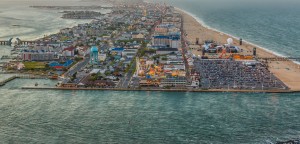
OCEAN CITY — The federal Army Corps of Engineers late this week is expected to begin an emergency dredging of the Ocean City Inlet that shoaled in even further during Winter Storm Jonas in late January although a long-term solution has not yet been reached.
An already challenging shoaling problem in the Inlet was exacerbated during Winter Storm Jonas in January, forcing the Army Corps of Engineers (ACE) to begin an emergency dredging project scheduled to begin on Friday.
While the Inlet and other channels in and around the mouth of the commercial harbor naturally fill in and are in need of continual maintenance dredging, the problem has become more acute in recent years to the point it is now curtailing commercial and recreational activity out of Ocean City. While the Army Corps and its state and local partners, including Worcester County and the town of Ocean City, are still exploring a long-term solution, an emergency repair is set to begin on Friday.
Ocean City Engineer Terry McGean on Monday confirmed the Army Corps’ dredge boat “Currituck” is scheduled to arrive on Friday and begin the emergency repairs in the Inlet. The “Currituck” will operate 24 hours a day for five days to affect the emergency repairs in the Inlet. McGean said it was his understanding the Corps’ project set to begin on Friday is an emergency measure and not part of a long-term solution.
After the “Currituck” completes its five-day emergency repair, the Army Corps dredge boat “Murden” is expected to arrive in Ocean City on March 24 for the normal twice-per-year maintenance project that includes dredging material from the Inlet and ebb shoal and depositing it on the north end of Assateague.
Congressman Andy Harris (R-Md.) late last week announced the Army Corps’ emergency dredge repairs at the Inlet. Harris has been working with Worcester County, Ocean City, local elected officials and all of the stakeholders including watermen and business owners on a long-term solution to the Inlet dredging problem, and commended the ACE for stepping in with the emergency dredge project this week.
“Shoaling is severely impacting the local economy and livelihood of commercial watermen while also creating safety issues for both commercial and recreational boaters,” he said. “Dredging in the Ocean City Inlet is crucial to the area and we have been working with all stakeholders, including Worcester County, the town of Ocean City, the watermen, waterfront businesses, local elected officials and the Army Corps of Engineers to ensure it is done in a timely manner and to find a lasting solution.”
While a long-term solution is still being explored, Harris said the Army Corps’ commitment to the short-term fix was good news for the resort area and its vast commercial and recreational fishing industries.
“It’s a win for the area to have the Army Corps of Engineers begin dredging in Ocean City next week and I commend them for working with us to make it happen,” he said.
Citing the increased need for frequent short-term dredging in the Inlet and surrounding areas in recent years, the ACE further agreed that a more comprehensive, long-term solution is needed and recommitted to dredging the channels as necessary for safe navigation as federal funding allows. Last year, it came to light the continued shoaling of the Inlet was negatively affecting commercial and recreational fishing and boating activities out of Maryland’s only Atlantic port to the point some commercial fishermen have moved their operations out the commercial harbor in West Ocean City.
To that end, the ACE is undertaking a series of actions to achieve a successful resolution to the chronic shoaling problem in the Inlet and surrounding channels. The first step is a Federal Interest Determination report, which is due by the end of this year. The report, if approved, will allow the ACE to study and model the hydrodynamics of the Inlet and harbor area to determine potential long-term solutions to the shoaling problem at 100-percent federal cost.
Following the hydrodynamics study, the Corps would then take up an effort to permanently increase the depth of the harbor to 14 feet and the Inlet to 16 feet as requested on behalf of the commercial and recreational fishermen.
Back in 1998, the Army Corps of Engineers completed its Ocean City, Maryland and Vicinity Water Resources Study, which correctly predicted many of the shoaling problems taking place now, but apparently the problems have developed more rapidly than predicted. At that time, the study recommended the Inlet and harbor depth be increased to 14 feet and 16 feet respectively. However, those plans were scrapped due to funding issues when the economy bottomed out.
The resulting negative economic impact to the city, county and state is millions of dollars in lost revenue, according to local officials. Some of the commercial vessels working out of the West Ocean City harbor have left the area and others are threatening to do so because of constant problems upon returning to the dock to unload their catches and damages to their fleets from bottoming out.

